BY JAMES P. ELLSON
On December 1, 2013, at 0722 hours, Fire Department of New York (FDNY) Rescue 3 (Special Operations Command) was special-called to respond to the Spuyten Duyvil section of the Bronx for a reported train derailment with possible civilians trapped. On arrival, just behind the first-due FDNY units, Rescue 3 was confronted with a southbound Metro-North Commuter Railroad (Metro-North) train that had derailed and was thrown across several hundred yards of track, with a wooded area and the waterfront beyond it (photo 1). A temporary command post was set up by the fence line. Metro-North is the second busiest commuter railroad in the United States in monthly ridership, behind the Long Island Rail Road, with service between New York City and its northern suburbs.
 |
| Photos by Steve Spak. |
RESCUE COMPANY OPERATIONS
Prior to entering the track area, on-scene units received a report from the Bronx borough dispatcher that all power to all three tracks at Spuyten Duyvil Station had been shut off. Metro-North trains may be powered by diesel locomotives or by electricity from a third rail or overhead catenary lines. The derailment occurred on a track section that used third-rail power-700 volts of direct current. Approaching the scene from the fence line, members saw the magnitude of this disaster. The officer of the first-arriving company, Engine 95, relayed a full report to the Bronx dispatch office. The first-due chief officer, Battalion Chief James McMorrow (Battalion 27), was not yet on the scene but was within radio range. As the officer in command of Rescue 3, I provided him a brief description, confirming that a commuter train had derailed and was over on its side, with an unknown number of victims, and also recommended that he transmit a 10-60 signal (the FDNY 10 code signal for a major emergency).
Rescue 3 members used a rotary rescue saw with an aluminum oxide blade to cut an opening in the fence and metal highway guardrail that ran alongside the tracks. The opening was large enough to accommodate the numerous civilians and emergency personnel who would be entering and exiting the scene. This would be the main access and egress for the duration of the operation.
SIZE-UP
Rescue 3’s inside team (an officer and two firefighters) proceeded to the track area with a light complement of hand tools including battery-powered spreading and cutting tools. At this time, the full scope of the disaster could be observed. A seven-car passenger train and its locomotive at the rear had derailed and come to rest in different degrees of stability with potential hazards involving electricity and water. The lead passenger car (car 1) was upright and just a few feet from the water’s edge (photo 2). This car, along with the next three cars (cars 2-4), had extensive damage to the exterior and interior, since those four cars appeared to have launched off the tracks and skidded, window-side down, for about 300 feet. The second passenger car lay on its right side, as did the third car. The fourth car was somewhat upright with the downtrack wheels positioned more than five feet off the ground. The car listed at a 45° angle, resting only on a gear box under one side (photos 3, 4). Its position was very unstable, and it had extensive exterior and interior damage. Cars 5-7 were separated from car 4 by 30 feet; although these cars had also jumped the tracks, they were still upright.
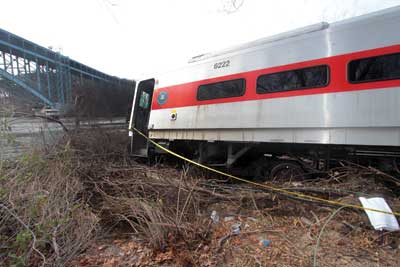

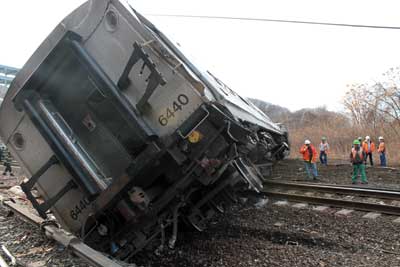
The diesel/electric locomotive was on its right side and leaking diesel fuel. Later in the operation, Haz-Mat Company 1 initiated fuel-removal operations (photos 5, 6). Most of the damage to the cars involved exterior window failure on both sides of the cars and interior damage to most of the seating in cars 2 through 4. Sliding pocket end doors between the cars that normally allow egress and exit between cars were damaged and unable to slide open.
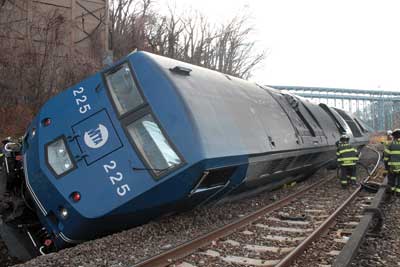
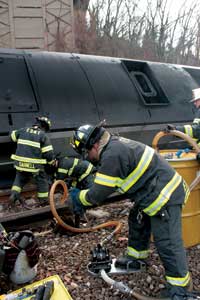
I ordered Rescue 3 to split into three teams of two each to cover as much of the train as quickly as possible, to assess the injuries of civilians still alive and trapped in the wreckage, and also to get a six-sided (four sides, top and bottom) view of the scene to identify any other hazards that would affect the operation’s safety. A six-sided view is a must in a general size-up. At this time, I decided to divide the search operation into two areas, one area consisting of cars 1-4 and the second of cars 5-7 and the locomotive. This was because cars 5-7 were still upright, and there were a smaller number of occupants in the locomotive.
I ordered two Rescue 3 firefighters to survey the train’s perimeter and report back any pertinent information and to find any other access to the front of the train. Two Rescue 3 firefighters surveyed the unstable condition of car 4. Another Rescue 3 firefighter and I entered the unstable car through a side window to search for victims. All Rescue 3 members followed the protocols covering a mass-casualty incident (MCI) and implemented a victim triage tagging system.
START TRIAGE SYSTEM
For an MCI, the most common and easily used system is simple triage and rapid treatment (START). Under this system, first responders check the victim’s breathing, circulation, and consciousness and, based on the first responder’s findings, FDNY personnel assign each casualty to one of five color-coded triage levels. The lowest level of injury, the walking wounded, is assigned a green tag, indicating those with minor injuries who can exit the incident area and proceed to a treatment area under their own power. The next level, delayed treatment (yellow tag), indicates those with nonlife-threatening injuries but who cannot get to a treatment area under their own power. Immediate treatment (red tag) is the highest level of triage, assigned to those with major life-threatening injuries who are savable. Patients meeting green or yellow criteria but who responders feel are more seriously injured can be designated with a new orange tag to indicate an urgency level between yellow and red. These patients need immediate advanced care but can wait until additional crews arrive. The lowest triage level (black tag) is for those who are obviously deceased or whose injuries are so severe that care would require more resources than are available.
VICTIM TRIAGE AND REMOVAL
Car 4. On entering car 4, we saw numerous passengers who needed immediate medical attention (red and orange tag victims). Since the car was unstable and was rocking back and forth, I determined that all passengers should be removed immediately. Two Rescue 3 and other on-scene firefighters accomplished this task, using a rescue patient packaging device. They safely removed the passengers through the low side exterior windows.
Car 3. A Rescue 3 firefighter accompanied me into car 3, which lay on its side. After removing the remaining glass, we climbed through the broken window of the end car door (a sliding pocket door), which had also failed in the crash and wouldn’t open. Inside, we noted three red, five orange, and numerous yellow tag victims. One black tag female victim was pinned under the car but was clearly visible from inside. One Rescue 3 firefighter was left in this car to provide medical attention.
Cars 1 and 2. Two Rescue 3 firefighters reported that car 1 had additional red tag and numerous yellow tag victims who needed medical attention. Rescue 3 personnel climbed through car 3 into car 2. Outside, they came upon 30 to 40 passengers, all walking wounded who had self-evacuated from the second car and were on the wooded side of the wreck. I instructed them to remain in place and await rescue personnel and relayed this information to McMorrow and Deputy Chief John Jonas of Division 7, who was now in command of the operation. By that time, roughly 10 companies and two battalions chiefs were on scene, approximately 60 FDNY Fire Branch personnel. New York Police Department and FDNY personnel escorted these passengers as a group across the tracks to the casualty collection area. The Rescue 3 firefighter in car 4 radioed me that all passengers in car 4 had been removed and that he and another Rescue 3 firefighter would assist with primary search of the second search area (cars 5-7) and also search the locomotive. Ladder 46 members relieved the Rescue 3 firefighter in car 3, who joined me in a search of car 2 starting from the uptrack end car doors. Two Rescue 3 firefighters finished their search of car 1 and started a search of car 2 from the downtrack side, which required them to squeeze through the failed windows of the end car doors of this car. Car 2 had numerous yellow and red tag victims as well as one black tag male victim who had been thrown from the train and now was pinned under the car.
Now that all the cars in the first search area had been searched and all victims properly triage tagged, Rescue 3 initiated and supervised an orderly system of victim removal. All green and yellow tag victims were removed from cars 2 and 3. Victim removal was very difficult, since the exit doors were inoperable and both cars were on their sides. All victims had to be assisted in climbing over all the seats and overhead storage racks to the end car bulkheads and squeezing through the end car door windows.
Next, all red tag patients were placed on backboards and properly packaged. Again, removal was difficult, but the injured were passed along member to member until each patient was removed from the cars.
REMOVAL OF TWO FATALITIES
Rescue 3 members reported that a search of the locomotive was negative and that the locomotive was powered down. I instructed the two firefighters that once they had completed search in area 2 (cars 5-7), they assemble a complement of tools required to extricate the two black tag victims. Assisted by Squad 61 of Special Operations Command, they set up by cars 2 and 3 a forward tool cache with hydraulic spreading/cutting tools, hydraulic jacks, air bags and controllers, and wood cribbing. With all red, orange, yellow, and green victims removed from the first four passenger cars, Rescue 3 members directed their attention to the two remaining black tag victims in cars 2 and 3. With the permission of FDNY command, they started the extrication of the first victim under car 2, working with Squad 61. They decided that the best course of extrication would be to dig around the victim instead of lifting the railcar and disturbing the car’s placement for the subsequent accident investigation. Members placed uninflated air bags on both sides of the victim as a secondary backup course of removal. The unearthing method was successful, and the victim was tunneled to through the hand-dug trench and removed from inside the passenger car through the center side exit doors that were facedown. The victim was placed on a backboard and handed out of the car by Rescue 3 members to awaiting emergency medical service personnel.
Rescue 3’s attention was now directed toward the black tag victim in car 3. Once again, climbing through the cars, members performed the same unearthing method of extrication, and this victim was also boarded and removed from the car by three firefighters. With all passengers removed from all the cars in both search areas, Rescue 3 members performed a secondary search of all cars, which was negative.
Rescue 3 joined Rescues 1 and 4 to assist them in shoring and securing the unstable car 4. Along with Squad 61, Rescue 3 set up rescue struts on the inboard side of car 4 while Rescues 1 and 4 rigged wire rope slings on the outboard side, securing the car back to two separate solid anchors using hand-operated, manual portable hoists (photos 7, 8).
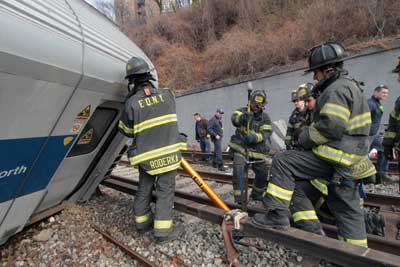
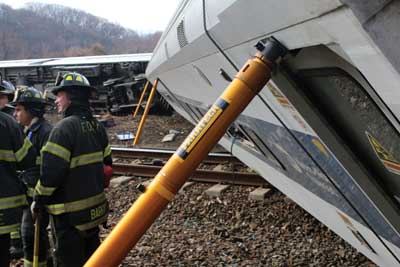
FDNY Special Operations Units operated at this incident for more than 24 hours, mitigating hazards to civilian and rescue personnel-electrical, leaking diesel fuel-and removing a large number of trapped and injured passengers. The search area was made extremely difficult because of the instability and resting position of all the cars. Although some victims died because of the extent of their injuries, more than 100 passengers on the train that day survived. This operation’s complexity tested the expertise and training of FDNY and Rescue 3.
JAMES P. ELLSON is a captain with the Fire Department of New York and company commander of Rescue 3. He is a member of the Special Operations Command Task Force and of New York Urban Search and Rescue Task Force 1 (NY-TF1).
Fire Engineering Archives


